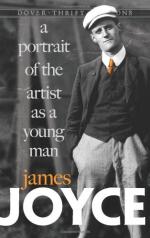|
|
A Portrait of the Artist as a Young Man Topic Tracking: Modernism
Part 1
Modernism 1: The first two pages of Portrait, so distinctive in style and technique, are an example of the experimentalism that made Joyce's writing so different from that of his 19th century predecessors. Stephen's way of perceiving the world affects the sound of the prose, making the boundary between the narrator and the character hard to determine.
Part 2
Modernism 2: The city and life within it are topics that the modernists often wrote about. Dublin exerts a defining influence on Stephen and the way he perceives the world.
Modernism 3: The way Stephen thinks when he's composing the poem to Emma (the tram girl) reflects a modernist theory of writing. Remove all but the most essential details and only suggest, rather than spell-out, the conflicts that lay beneath the scene. Ernest Hemingway called this "The Iceberg Theory," meaning a writer shows only the alluring tip of what may really be a huge conflict.
Modernism 4: Joyce is not afraid to write honestly about sex. In an era when writers were expected to be discreet, if not downright prudish about portraying sex, the scene between Stephen and the prostitute is quite daring.
Part 3
Modernism 5: The disproportionate number of pages that the sermons are allotted in the novel demonstrates a style of writing contrary to the modernist philosophy that only the most essential details should be shown. Joyce had a way of breaking rules.
Part 4
Modernism 6: The "mimetic technique" that was more widely used by modernist writers is clearly shown in the pages after Stephen decides he won't join the priesthood. As Stephen's mood surges and soars, so does the writing. Mimetic writing mimics the character's mood and mind.
Modernism 7: Stephen's thoughts about his own name bring up the issue of myth and modernism. Modernist writers like Joyce (T.S. Eliot is another example) had a respect for writers and ideas of the past and often referenced myths and mythical characters in their work.
Modernism 8: Stephen's decision to devote himself to art after he sees the bird girl is an example of an "epiphany." Epiphanies, often portrayed in modernist writing, happen when a character is transformed in one moment of penetrating insight.
Part 5
Modernism 9: When Stephen thinks as he's walking to school about "common lives," he's expressing a modernist's concern for the lives of people who are not rich or well-known. Modernist writing often portrays the very real problems of characters that may not have been considered "literary" enough in times past.
Modernism 10: When Stephen looks at Maple's Hotel, full of boring middle-class people too comfortable to be affected by art, his reaction of contempt expresses the modernist attitude that true art must be created for art's sake only, not in the hopes of changing people (who are often too silly or stubborn to be changed).
Modernism 11: Stephen's decision to take on art and the world alone shows a notion of individuality that was relatively novel in this time period. In the modern era, the idea of one person taking on the world (vs. a person acting as part of a community) became a more popular way of thinking about the self.




